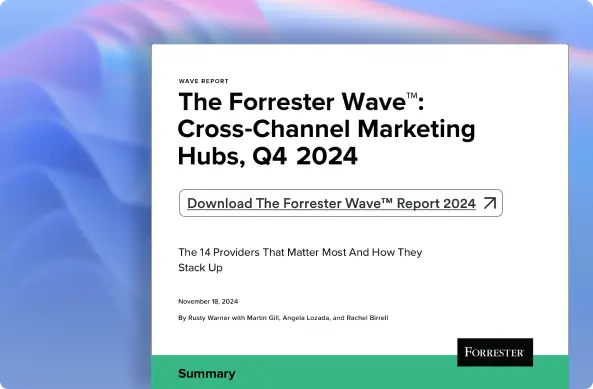The European Accessibility Act 2025: What Businesses & Marketers Need to Know (and Do!)

Reading Time: 5 minutes
In today’s digital world, it’s easy to get caught up in trends and metrics. But let’s pause for a moment and talk about something that truly matters: making sure everyone feels welcome and included online. We’re talking about accessibility, as mentioned in the European Accessibility Act (EAA). But it’s not just a buzzword or a legal checkbox; it’s about genuine connection.
When we create content that everyone can access, we’re not just being ethical; we’re building stronger customer relationships and opening doors to opportunities we might have missed. Let’s unpack what accessibility is all about, why it’s essential, what the European Accessibility Act requirements are, and how MoEngage supports these efforts.
What Exactly Is Accessibility?
Accessibility, particularly as defined by the European Accessibility Act (EAA), is all about making sure that people with disabilities aren’t left behind. We’re talking about breaking physical, social, and even attitudinal barriers to deepen customer engagement.
At MoEngage, we’re committed to equipping our clients with platform features that support accessibility best practices and giving them the guidance they need to meet those important compliance standards.
Why Should You Care About Accessibility?
(Hint: It’s more than just “doing the right thing”).
Accessibility absolutely is the right thing to do. But it’s also a really smart business move. Here’s why:
- You’re missing out on a huge market: Did you know that the World Health Organization (WHO) estimates that 1.3 billion people – that’s 16% of the world’s population – experience significant disability? Their online spending power is huge, estimated at around €30 billion. When you make your content accessible, you’re opening your doors to a massive audience that’s often overlooked.
- Happy users = Happy business: When your website is easy to use for everyone, you’re going to see a boost in engagement, sales, and customer satisfaction. Think about it: if navigating your site is a breeze, people are more likely to stick around and come back. In fact, in 2021, Ecommerce retailers lost an estimated $828 million during the holiday season due to inaccessible websites. That’s a lot of missed potential.
- Your brand gets a gold star: When you show you care about accessibility, you’re showing you care about all your customers. That builds trust and loyalty, and it gives your brand a positive, inclusive reputation.
- It’s a legal requirement: Of course, there’s also the legal side of it – the European Accessibility Act (EAA). It’s important to be aware that compliance isn’t optional, and there can be serious repercussions, so it’s best to get ahead of it.
What is the European Accessibility Act (EAA) 2025?
The European Accessibility Act (EAA) is a 2019 legislation that was adopted by EU nations starting in 2022, to ensure that all digital experiences are Perceivable, Operable, Understandable, and Robust (POUR) for all consumers with disabilities across the EU. Essentially, it’s all about making sure that a wide range of products and services – websites, Ecommerce platforms, e-books – are always accessible to such people.
The deadline to comply with the EAA is June 28, 2025, so now’s the time to take action.
Who Does the European Accessibility Act Apply To?
Basically, everyone.
If you’re a public sector body, a private company, a non-profit, a manufacturer, a retailer, a service provider, or a digital platform offering goods or services in the EU, the EAA applies to you. Non-compliance can lead to hefty penalties.
What Are the Consequences of Non-Compliance with the European Accessibility Act?
Fines for not complying with the EAA can vary across EU member states. For example, in Ireland, fines can reach €60,000 and include 18 months of imprisonment, while in Germany, non-compliance fines can reach €500,000.
On top of the massive fines, you could be subject to mandatory audits, product suspensions, legal action, and inevitable damage to your reputation.
What You Can Do to Comply with the EAA 2025
Here’s a simple roadmap to get you on the right track for compliance with the European Accessibility Act in 2025:
- Start with an audit: Take a good look at all your digital materials (website, apps, social media, emails). Identify any accessibility gaps.
- Conform with EN 301 549: To prove that your brand complies with the European Accessibility Act, you need to conform with EN 301 549, which includes the Web Content Accessibility Guidelines (WCAG) 2.1 Level AA criteria.
- Give your website some love: Add alt text, captions, and ensure your site is easy to navigate with just a keyboard.
- Get your team on board: Train your marketing team. Make sure they know the ins and outs of accessibility and the EAA.
- Ask for feedback: Get users with disabilities to test your stuff. Their input is invaluable.
- Keep learning: Accessibility standards evolve, so keep your knowledge fresh.
- Make it a priority: Don’t treat accessibility as an afterthought. Bake it into your digital marketing strategy from day one.
What Are the European Accessibility Act Requirements?
To make digital experiences accessible to all consumers, the European Accessibility Act outlines some requirements for EU brands to follow, no matter what. Let’s look at some easy ways you can boost accessibility on your website.
- Captions are key: Add captions to all your videos, along with transcripts and audio descriptions.
- Alt text for images: Describe what’s in your pictures as image alt text.
- Contrast is your friend: Ensure proper colour contrast, so that text is easy to read against the background.
- Organize like a pro: Use headings, accessible fonts and themes, and clear formatting.
- Make it user-friendly: Keyboard navigation, clear feedback, and consideration of different screen sizes go a long way.
How MoEngage Ensures European Accessibility Act (EAA) Compliance
The MoEngage platform is designed with accessibility, inclusivity, and compliance in mind, helping businesses and marketers meet these regulations. Below is a breakdown of specific features and functionalities in MoEngage that align with the EAA, and how they assist businesses in addressing the legislation’s requirements:
1. Customizable Campaign Templates
MoEngage provides marketers with the tools necessary for creating WCAG (Web Content Accessibility Guidelines) compliant marketing campaigns across email, in-app messages, and web or push notifications. WCAG compliance—which includes readable text, proper color contrast, and screen-reader compatibility—is mandatory for accessible digital communication.
2. Multi-Language Support
MoEngage supports multiple languages, enabling businesses to create localized campaigns for diverse audiences within Europe. Accessibility legislation requires content to be understandable for people in their preferred local language.
3. Device and Channel Compatibility
MoEngage enables omnichannel campaigns across email, SMS, push notifications, in-app messages, and onsite messaging, all optimized for various device formats, including screen readers and assistive technologies. The EAA mandates that digital services must be accessible across different devices (mobile, web, laptops) and compatible with assistive tools used by disabled individuals.
4. Real-Time Accessibility Previews
MoEngage will soon provide a preview tool within its Email, In-App, and Onsite messaging content editors to check accessibility. This tool will highlight potential issues, such as poor color contrast or unreadable fonts, before campaigns are published, allowing marketers to correct errors and ensure compliance and inclusivity.
Ensure Inclusive Online Experiences with MoEngage
MoEngage is designed to help businesses thrive in the AI and accessibility-driven future by ensuring full compliance with the European Accessibility Act (EAA), enabling inclusive engagement, and streamlining operations. Every feature—from accessibility previews to alt-text automation—empowers marketers to reach more customers while demonstrating their commitment to equality and accessibility.
So, what are you waiting for? See MoEngage in action today.













